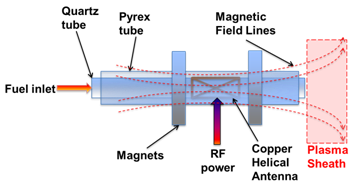Sponsors: National Science Foundation (NSF)
NASA Space Technology Research Fellowship (NSTRF)
Collaborators: N/A
A radio frequency (RF) powered helicon thruster was developed to research its suitability for use as a low thrust electric space propulsion system. The helicon thruster consists of a quartz glass tube filled with gaseous fuel surrounded by a copper antenna which is attached to an RF power supply. Current through the antenna generates a time varying magnetic field and curling electric field that excites electrons in the gas, creating plasma. Magnets provide axial magnetic field lines that allow for the creation of helicon waves, a low frequency electromagnetic wave. Thrust is produced by the acceleration of charged particles through the plasma sheath that forms at the thruster exit. The helicon thruster has several advantages over other electric propulsion systems. Helicon waves have a higher ionization efficiency than capacitive and inductive coupling, requiring less energy per ion. The RF antenna powering the thruster is not immersed in the plasma, making it less susceptible to erosion. Equal numbers of ions and electrons are expelled at the exit, eliminating the need for a neutralizer in the exhaust plume.
 To increase thruster efficiency, permanent magnets will be implemented with the assistance of a type II superconductor to control the shape of the magnetic field geometry. Permanent magnets can offer a strong magnetic field at no power cost, however the non-uniformity of the fields and in some cases the presence of nulls make these field structures sub-optimal for helicon source operation. A possible solution is the integration of strong permanent magnets with superconducting materials to shape the magnetic fields at a much lower power cost.
To increase thruster efficiency, permanent magnets will be implemented with the assistance of a type II superconductor to control the shape of the magnetic field geometry. Permanent magnets can offer a strong magnetic field at no power cost, however the non-uniformity of the fields and in some cases the presence of nulls make these field structures sub-optimal for helicon source operation. A possible solution is the integration of strong permanent magnets with superconducting materials to shape the magnetic fields at a much lower power cost.
The focus of this research is to investigate thruster performance using superconducting permanent magnets and water vapor as a fuel instead of noble gases. Water vapor is safe to store and more plentiful than noble gases in deep space, allowing for the possibility of refueling deep space probes.